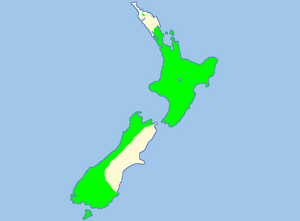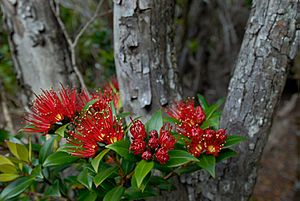Southern rātā facts for kids
Quick facts for kids Southern rātā |
|
|---|---|
 |
|
| Southern rātā near Franz Josef Glacier | |
| Scientific classification | |
| Genus: |
Metrosideros
|
| Species: |
umbellata
|
 |
|
| Distribution of M. umbellata in mainland New Zealand. Auckland Islands not shown. | |
| Synonyms | |
|
Metrosideros lucida (G. Forst) A. Rich |
|
Metrosideros umbellata, the southern rātā, is a tree endemic to New Zealand. It grows up to 15 metres (49 ft) or more tall with a trunk up to 1 metre (3 ft 3 in) or more in diameter. It produces masses of red flowers in summer. Unlike its relative, northern rātā, this species rarely grows as an epiphyte.
Description
The flowers of southern rātā are scarlet, with stamens about 2 centimetres (0.79 in) long. White or yellow flowers are also known. Flowering usually occurs between December and February, but this depends on local conditions. Leaves are from 3 centimetres (1.2 in) to 6 centimetres (2.4 in) long, and are sharply pointed. The wood is hard, dense, and very strong. The bark is rough and flaky and provides an ideal stratum for the roots of epiphytic plants such as Astelia species and Freycinetia banksii (Kiekie). Southern rātā is a major source of honey on the West Coast of the South Island. Kaka, tui, and bellbirds visit rātā to take advantage of the abundant nectar.
Distribution
It prefers cooler regions with high rainfall and is particularly common along the west coast of the South Island where its nectar is the main source of a locally produced rātā honey. Southern rātā is the most widespread of the New Zealand tree rātā species. It is locally present in the North Island from latitude 36° southwards, is more common in western parts of the South Island but absent from much of the east, and is common on Stewart Island (47°S) and in the Auckland Islands, where it reaches its southern limit at just over 50°S.
Conservation
Although southern rātā is not regarded as threatened, it is rather uncommon in the North Island, and in certain areas it is threatened by possum browse. In the Tararua range, southern rātā populations appear to have been replaced by a population consisting of hybrids between northern and southern rātā.
Project Crimson is a charitable trust that promotes conservation of rātā as well as the related pōhutukawa.
Cultivation
Southern rātā is a beautiful specimen tree, but growth can be slow unless it is grown in ideal conditions with moist soil. It is easily grown from fresh seed. While it is possible to grow the tree from softwood or semi-hardwood cuttings, these often prove reluctant to strike roots. It is ideal for coastal environments because it has a good resistance to wind and salt.
At least 16 cultivars of southern rātā have been released. There are also known cultivars of hybrids between southern rātā and pōhutukawa, and between northern rātā and southern rātā. Known cultivars include:
| Cultivar name | Year introduced | Flower colour | Introduced by | Notes |
|---|---|---|---|---|
| M. umbellata ‘Alba’ | mid-1980s | White/cream | Denis Hughes | Leaves are a paler lemon-green then standard plants. Sourced from Soaker Hill in the Catlins, South Otago. |
| M. umbellata ‘Christmas Dream’ | Late 1970s | Red | Denis Hughes | Sourced from Lake Manapouri. |
| M. umbellata ‘Denniston Yellow’ | 1995 | Sulphur Yellow | Deane Keir | Sourced from the Denniston Plateau. |
| M. umbellata ‘Fireball’ | 1993 | Bright crimson | Deane Keir | Sourced from the Stockton Plateau at a place called Burning Mine. |
| M. umbellata ‘Firecracker’ | 1995 | Deep red | Jeff Elliott | Sourced from Whanganui Inlet, North-West Nelson. |
| M. umbellata ‘Gold Beacon’ | - | Sulphur Yellow | Les Cleveland | Sourced from the Otira Gorge. |
| M. umbellata ‘Gold Nugget’ | 1992 | Red | Joe Cartman | Golden new leaves with thin red leaf margins. Sourced from side-shoot of M. umbellata ‘Harlequin’. Also sold as M. umbellata ‘Lownug’. |
| M. umbellata ‘Harlequin’ | md-1980s | Red | Joe Cartman | Variegated cultivar with yellow leaf margins. Sourced from Nugget Point. |
| M. umbellata ‘Kaka’ | late-1990s | Pink | Denis Hughes | Sourced from Kaka Point, Otago. |
| M. umbellata ‘Moonlight’ | 2001 | Red | Pattersons Nurseries | Reverse variegated cultivar. Sourced from side-shoot of M. umbellata ‘Gold Nugget’. Also sold as M. umbellata ‘Lowmoo’. |
| M. umbellata ‘Mt Augustus’ | Late-1970s | Red | Louise Salmond | Sourced from the Stockton Plateau at a place called Mt Augustus. |
| M. umbellata ‘Red Tips’ | Mid-1990s | Red | Les Cleveland | New leaves have a red tip. Sourced from an island in Lake Wanaka. |
| M. umbellata ‘St Nicholas’ | Late 1970s | Red | Denis Hughes | Sourced from Lake Manapouri. |
| M. umbellata ‘Scarlet Beacon’ | 2002 | Red | Les Cleveland | - |
| M. umbellata ‘Silver Beacon’ | Mid-1990s | Red | Les Cleveland | New leaves have a silvery tip. Sourced from an island in Lake Wanaka. |
| M. umbellata ‘Sparrow’s Hybrid’ | 1994 | Red | Mr Sparrow | Sourced from the banks of the Avon River in Christchurch, between Madras and Manchester Streets. Source material provided by Mr Sparrow, a customer of the nursery. Despite the name, this cultivar is not a hybrid. |
| ¤ Metrosideros ‘Cleveland Red’ | late-1990s | Scarlet | Les Cleveland | Deliberate interspecific hybrid. |
| ¤ Metrosideros ‘Maungapiko’ | 1985 | Bright crimson | Graeme Platt | Sourced from Maungapiko Track, Great Barrier Island. |
| ¤ Metrosideros ‘Rustic Beauty’ | 1985 | - | Les Cleveland | Deliberate interspecific hybrid. |
| ∞ Metrosideros ‘Sentinel Flame’ | 2007 | Bright red | Graeme Platt / Vibrant Earth nursery | Sourced from either Great Barrier Island or North-West Nelson. |
∞ Hybrid of southern rātā and northern rātā
¤ Hybrid of southern rātā and pōhutukawa
See also
 In Spanish: Árbol rata del sur para niños
In Spanish: Árbol rata del sur para niños


